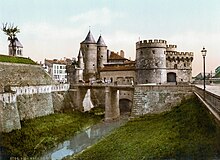Coming Metz

The Kommende Metz was a branch of the Teutonic Order near the German Gate in Metz . Upcoming were the smallest organizational units of the Teutonic Order , which were regionally combined into Balleien . The branch in Metz was part of the Deutschordensballei Lothringen , based in Trier .
history
The circumstances of the foundation of the Kommende Metz are so far unknown. It becomes tangible for the first time with the documentary mention of a priest brother as commander in 1245. At this time, the new building of the Metz coming building can be assumed. The Church of the Coming was consecrated in 1268. As a result of pious donations received by the comer, properties were bought in the following years, such as the patronage of the parish church of Habkirchen . After the city of Metz was conquered by the French King Henry II in 1552, the future buildings were demolished and the city walls reinforced in their place. The commander was then officially canceled and part of her property was assigned to the commander in Trier. The last Metz Komtur Johann von der Fels took over the Kommende Saarburg on the upper Saar after his expulsion . However, his health was so weak that he was soon replaced by Johann von Eltz and had to be cared for in the Kommende Beckingen. In 1577 he was officially returned to head of the Kommende Saarburg, but then seems to have stayed in Beckingen.
The German Gate ( French Porte des Allemands ) was named after the neighboring former hospital of the Teutonic Order , which was established near the Church of St. Eucharius ( Saint-Eucaire ). The name should therefore also be translated with Deutschherrentor . The Torburg formed the main entrance to the city of Metz from the east.
Commander of the Coming Metz
- Conrad (13th century)
- Adam von Waldrach (1517–1527)
- Johann von der Fels (until 1552)
literature
- Rüdiger Schmidt: Die Deutschordenskommenden Trier and Beckingen 1242 - 1794, (Sources and studies on the history of the Teutonic Order, Vol. 9), Marburg 1979.
- Marian Tumler: The German Order in becoming, growing and working until 1400 with an outline of the history of the Order from 1400 to the most recent time, Vienna 1955.
Individual evidence
- ^ A b Marian Tumler: The German Order in Becoming, Growing and Working until 1400 with an outline of the history of the Order from 1400 to the most recent times, Vienna 1955, p. 132.
- ^ Rudolf Fendler, History of the Teutonic Order in Einsiedel near Lautern (Sources and Treatises on Middle Rhine Church History, 55), Mainz 1986, p. 53.
- ^ A b Rüdiger Schmidt: Die Deutschordenskommenden Trier and Beckingen 1242 - 1794, (Sources and studies on the history of the Teutonic Order, Vol. 9), Marburg 1979, p. 332.
- ^ Rüdiger Schmidt: Die Deutschordenskommenden Trier and Beckingen 1242 - 1794, (Sources and studies on the history of the German Order, Vol. 9), Marburg 1979, p. 314.
- ^ Rüdiger Schmidt: Die Deutschordenskommenden Trier and Beckingen 1242 - 1794, (Sources and studies on the history of the Teutonic Order Vol. 9), Marburg 1979, pp. 309-310.
